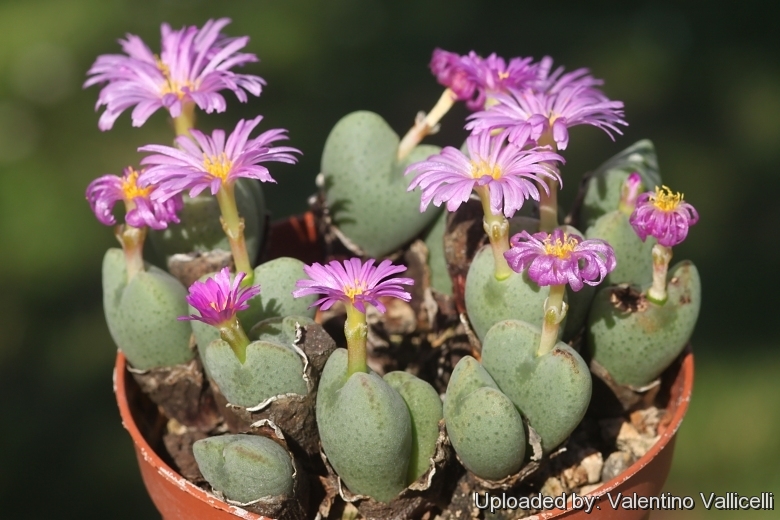
Conophytum velutinum Photo by: Valentino Vallicelli
Origin and Habitat: South Africa (Northern Cape, Little Namaqualand)
Habitat: Growing in a well drained soil with some water in winter and some sun.
Synonyms:
See all synonyms of Conophytum velutinum
back
Accepted name in llifle Database:Conophytum velutinum SchwantesMöller's deutsche gärtner-zeitung 42: 139 1927Synonymy: 7
back
Common Names include:
ENGLISH: Living Pebbles
Description: Richly branched species closely relatated to the Conophytum bilobumSN|1283]]SN|1166]] but with pink-violet blooms. This would appear to be very similar in form and size to Conophytum cordatumSN|1166]]SN|1283]].
Bodies (paired leaves): About 1 cm in dieter cordate (heart-shaped) in outline. Greyish-green, velvety or appearance.
Flowers: Petals spreading, light violet to magenta.
Blooming season: The flowers are autumnal and diurnal.
Subspecies, varieties, forms and cultivars of plants belonging to the Conophytum velutinum group
Notes: Plants of the genus Conophytum are also known as 'living pebbles'. During the rest period (the summer months in Europe) a new body forms inside the old, gradually taking all the substances from it until all that remains is the skin, which dries and protects the young plant from the heat of the sun and excess evaporation of water. The resting Conophytum protected by this dry cover resembles a pebble and hence the name 'living pebble'. The growth period of most species is from August to March. The temperature should be about 10 to 12°C.
Bibliography: Major references and further lectures
1) Heidrun E.K. Hartmann “Illustrated Handbook of Succulent Plants: Aizoaceae A-E” Springer, 2002
2) Gideon Smith u.a. “Mesembs of the World: Illustrated Guide to a Remarkable Succulent Group.” Briza Publications, 1998
3) Hermann Jacobsen “A handbook of succulent plants: descriptions, synonyms, and cultural details for succulents other than Cactaceae, Volume 1” Blandford Press, 1960
4) Hermann Jacobsen, Vera Higgins “Succulent Plants: Description, Cultivation and Uses of Succulent Plants, Other Than Cacti” Williams and Norgate, Limited, 1935
5) Werner Rauh “The Wonderful World of Succulents:Cultivation and Description of Selected Succulent Plants Other Than Cacti” Smithsonian Institution Press, 1984
6) James Cullen, Sabina G. Knees, H. Suzanne Cubey “The European Garden Flora Flowering Plants: A Manual for the Identification of Plants Cultivated in Europe, Both Out-of-Doors and Under Glass” Cambridge University Press, 11/ago/2011
7) Steven A. Hammer “Dumpling and his wife: new views of the genus Conophytum” EAE Creative Colour Ltd., 2002
8) Steven A. Hammer “The genus Conophytum: a conograph Succulent Plant Publications” 1993
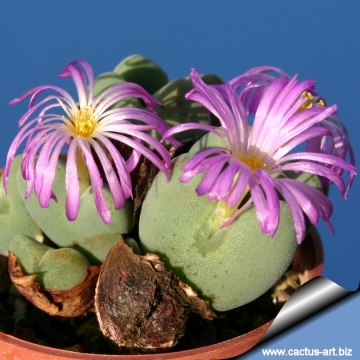 Conophytum velutinum Photo by: Cactus Art
Conophytum velutinum Photo by: Cactus Art Resting phase (summer) Photo by: Valentino Vallicelli
Resting phase (summer) Photo by: Valentino Vallicelli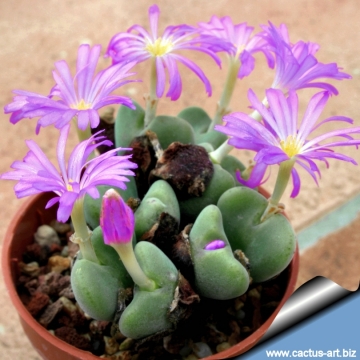 Conophytum velutinum Photo by: Cactus Art
Conophytum velutinum Photo by: Cactus Art Conophytum velutinum Photo by: Valentino Vallicelli
Conophytum velutinum Photo by: Valentino Vallicelli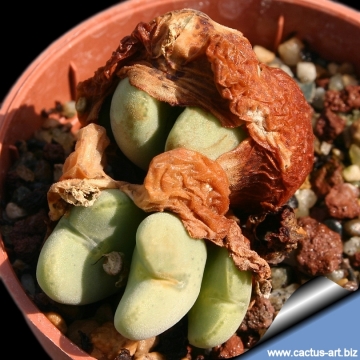 Conophytum velutinum Photo by: Cactus Art
Conophytum velutinum Photo by: Cactus Art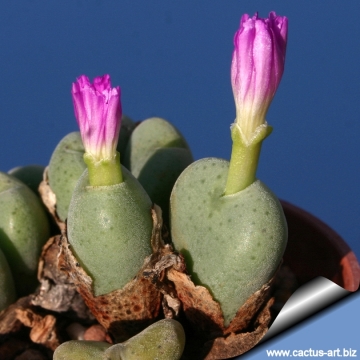 Conophytum velutinum Photo by: Cactus Art
Conophytum velutinum Photo by: Cactus Art Conophytum velutinum Photo by: Valentino Vallicelli
Conophytum velutinum Photo by: Valentino Vallicelli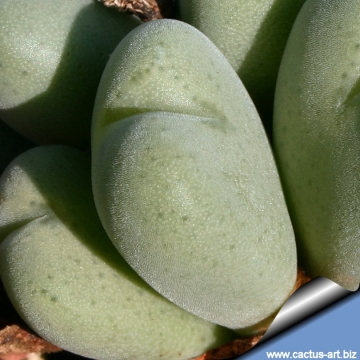 Conophytum velutinum Photo by: Cactus Art
Conophytum velutinum Photo by: Cactus ArtCultivation and Propagation: All the forms of C. velutinum are easy to grow. These plants grow on winter rain and head for summer dormancy. They require little water; otherwise its epidermis breaks (resulting in unsightly scars). Water minimally in summer, (only when the plant starts shrivelling), but it will generally grow even in summer if given water. Water regularly in winter after the previous year's leaves have dried up. Requires good drainage. Keep cool and shaded in summer, it needs full sun or light shade. Hardy to -2°C. Ensure a very good ventilation. Avoid to repot frequently. This plant may stay in the same pot for many years.
**Propagation:*** It can be reproduced both by cuttings and seeds. Take the cutting from a grown-up mother plant. Each cutting must contain one or more heads along with a fraction of root.
Your Photos
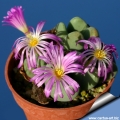
by Cactus Art




















